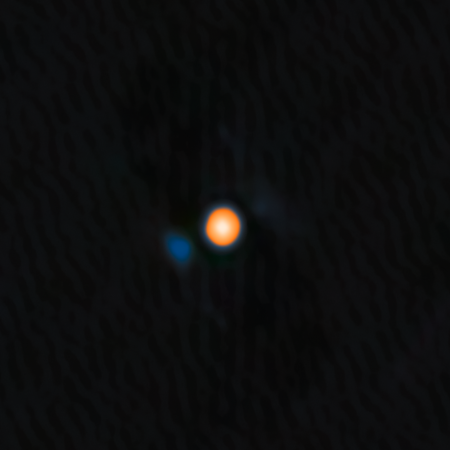Fast Facts
-
Ground-based telescopes, including the Gemini North telescope in Hawai’i, successfully detected a previously elusive companion star to Betelgeuse using a special high-resolution camera, overcoming atmospheric distortion that hindered space-based efforts.
-
The companion star was found orbiting close to Betelgeuse, and its discovery may help explain the periodic brightness changes in similar red supergiant stars.
-
Researchers named the companion "Siwarha," meaning "her bracelet," to complement Betelgeuse’s original name, which has roots in Arabic lore.
- The NASA–NSF Exoplanet Observational Research Program (NN-EXPLORE) aims to enhance U.S. exoplanet science by facilitating follow-up observations from ground-based facilities, integrating findings from space missions.
NASA Scientist Finds Predicted Companion Star to Betelgeuse
NASA’s latest discovery shines a light on a long-speculated companion star to Betelgeuse, the famous red supergiant in the Orion constellation. Researchers initially used space-based telescopes for observations. However, Earth’s atmosphere can blur images of celestial objects, making it challenging to spot the companion.
Steve Howell, a senior research scientist at Ames Research Center, identified a unique opportunity. He turned to the Gemini North telescope in Hawai’i, one of the world’s largest ground-based telescopes. Equipped with a special high-resolution camera known as the ‘Alopeke speckle instrument,’ the telescope could overcome atmospheric distortions. This advanced imaging device captured thousands of short exposures, which helped researchers process the data more accurately.
Ultimately, Howell’s team detected the faint companion star right where predictions placed it. It orbits closely to Betelgeuse, providing an exciting breakthrough in understanding these massive stars. Howell expressed his hope that this discovery would inspire fellow astrophysicists. He noted that the capabilities of ground-based telescopes and speckle imagers could unveil "great mysteries" of the universe.
Notably, this close companion may explain the periodic brightness changes observed in other similar red supergiant stars. Howell intends to continue studying the companion star to better characterize its nature. Interestingly, this star will reach its furthest distance from Betelgeuse in November 2027, making future observations easier.
Turning to nomenclature, Howell’s team named the newly discovered companion “Siwarha,” meaning “her bracelet” in Arabic. This name complements the original meaning of Betelgeuse, which translates to “the hand of al-Jawza’.”
This work falls under the NASA–National Science Foundation Exoplanet Observational Research Program (NN-EXPLORE). This initiative enhances U.S. exoplanet science by providing essential access to advanced observational facilities. Managed by NASA’s Exoplanet Exploration Program, NN-EXPLORE supports the scientific endeavors of missions like Kepler and the James Webb Space Telescope. Such collaborations create strong synergies between discovery and follow-up observations.
For those interested in exploring more about NN-EXPLORE, additional information is available online. The implications of this discovery may have lasting impacts, not only on astronomy but also on technology development in observational science.
Stay Ahead with the Latest Tech Trends
Stay informed on the revolutionary breakthroughs in Quantum Computing research.
Stay inspired by the vast knowledge available on Wikipedia.
SciV1

